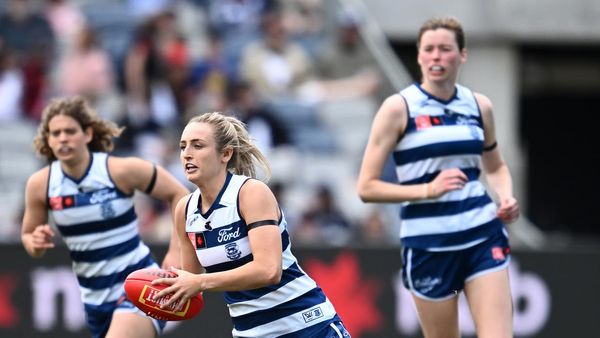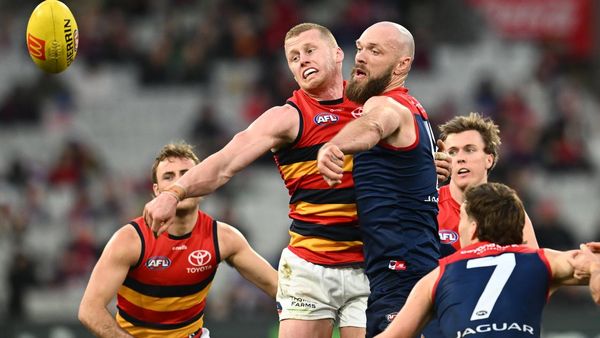
The first week of AFLW finals could be considered something of a dream run for the league. Unexpected winners, break-out games and large crowds – there have been storylines are aplenty.
There was the sight of last year’s winless Sydney Swans storming into a semi-final while three-time premiers Adelaide got pipped at the post. There was heartbreak and elation for the Prespakis family as sisters Maddy and Georgie traded goals in the qualifying final between Essendon and Geelong, before Georgie’s Cats emerged victorious.
Amid all the excitement, one notable trend emerged: the size of the winning margins. Aside from Brisbane’s narrow win over the Crows on Saturday, the round’s remaining games were largely one-sided.
Just two points separated powerhouses Brisbane and Adelaide, but the margins steadily widened as the weekend progressed, culminating in a 41-point annihilation of reigning premiers Melbourne by underdogs North Melbourne. Prior to that shellacking, Geelong defeated Essendon by 18 points, and Gold Coast fell to the Swans by 17.
Such clear results well in advance of the final siren was an issue the AFL specifically sought to alleviate ahead of the season’s commencement.
In order to make games higher scoring and avoid giant blowouts on the scoreboard, the league introduced some rule changes, including a cap of 60 interchanges a game and extending the quarter lengths by two minutes to promote fatigue and encourage stronger contest in the defensive side of things.
At the time, AFL executive general manager Laura Kane, said: “These rule adjustments will give supporters more of what they love – a balance between attack and defence, improved strategic tension, and encourage more instinctive play.” But on the evidence so far, that is up for debate.
The Demons’ result, in particular, stood out – not just for the size of the defeat, but because they have been dominant all season, finishing second on the ladder. Not only was the margin catastrophic, but the Demons were also held to just one goal all day, licking their wounds as they exited Ikon Park with just nine points.
What was even more remarkable is that the joint league-leading goalkickers, Melbourne teammates Kate Hore and Eden Zanker, both failed to get on the board.
“We’re really disappointed. We’re thankful that we had a strong enough home-and-away season that we’ve got a double chance, we’ll certainly use that,” Demons coach Mick Stinear said following the game.

The highest winning margin in AFLW history is 96 – when the Crows hammered the Giants last year. The rule changes appear to have gone some way to remedying that gap, but it is telling that three of four games had upwards of 17-point gaps.
Geelong finished on 51 to Essendon’s 33, and while that scoreline indicates that the Bombers were in it, they only began to really contest when it was too late. The Cats were the obvious victors from early on, getting three goals in the first eight minutes, and remained firmly on top until the Bombers fought hard to minimise the 38-point three-quarter-time margin.
Similarly, the Swans came out hard on the Gold Coast, with a four-goal opening quarter and a lead which the Suns never truly threatened.
The ideal scenario is to have close games and thrilling finishes, but in week one of finals, North Melbourne and Geelong led the entirety of their games, and Gold Coast were only in front of Sydney for seven minutes of their game. Adelaide was the only team that managed to have a lead at a break and lose the game.
Aside from the obvious outliers, the key appears to be to avoid the onset of exhaustion and get in front early, before the extended game time and capped interchanges wear the group down. Interestingly, all eight sides used between 52 and 58 interchanges of a possible 60, indicating a high fatigue rate.
The concern is if blowouts continue deeper into the finals series, the league could lose valuable spectators. But there is a flip side – teams coming out on top include those which don’t often feature in the business end of the season.
Next weekend, the Swans, who have never played finals before, will face triple premiers Adelaide in an intriguing semi-final match-up – the Crows finished top of the ladder of the home-and-away season, while Sydney snuck in at eighth.
If this past week is anything to go by, the Swans have a few surprises up their sleeves, and hopefully the 83.9 difference in the two side’s percentages will not be visible on Saturday night.










